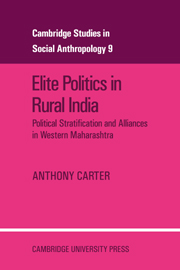 Elite Politics in Rural India
Elite Politics in Rural India from Part 3 - Political alliances
Published online by Cambridge University Press: 02 March 2010
Horizontal political alliances link elite leaders with other elite leaders and with members of the political class who have not entered the elite. They occur in all political arenas and on all occasions of political action. The number of horizontal alliances is greater in more inclusive areas, but nowhere do they disappear entirely. Many positions of influence over the distribution of political patronage are obtained in periodical elections by means of direct or indirect appeal to the mass of the voters. However, the actual distribution of patronage is decided continuously by a small group of elite leaders. Therefore, even though vertical alliances are often unnecessary, a successful politician must maintain his horizontal alliances constantly intact.
With horizontal as with vertical political alliances the crucial factor continues to be patronage transactions of one sort or another, but in other respects the two kinds of alliance are quite different. Vertical alliances are either inter-caste links or else links between v∂t∂ndar and non-v∂t∂ndar Marathas. They generally involve economic or status transactions for which kinship rarely is a pretext. Horizontal alliances, on the other hand, tend to be intra-caste, linking one v∂t∂ndar Maratha with another, although inter-caste links involving Brahmins, Gujars, and so on also occur. They involve patronage or support transactions for which kinship is not infrequently a pretext. However, the kind of kinship connections which are available to politicians vary with the inclusiveness of the political arena. In no case is there a one-to-one correspondence between political alliances and ties of kinship.
To save this book to your Kindle, first ensure [email protected] is added to your Approved Personal Document E-mail List under your Personal Document Settings on the Manage Your Content and Devices page of your Amazon account. Then enter the ‘name’ part of your Kindle email address below. Find out more about saving to your Kindle.
Note you can select to save to either the @free.kindle.com or @kindle.com variations. ‘@free.kindle.com’ emails are free but can only be saved to your device when it is connected to wi-fi. ‘@kindle.com’ emails can be delivered even when you are not connected to wi-fi, but note that service fees apply.
Find out more about the Kindle Personal Document Service.
To save content items to your account, please confirm that you agree to abide by our usage policies. If this is the first time you use this feature, you will be asked to authorise Cambridge Core to connect with your account. Find out more about saving content to Dropbox.
To save content items to your account, please confirm that you agree to abide by our usage policies. If this is the first time you use this feature, you will be asked to authorise Cambridge Core to connect with your account. Find out more about saving content to Google Drive.